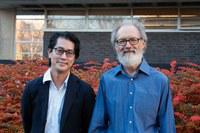The prize will be awarded during a ceremony hosted by “Family Guy” creator Seth Macfarlane and broadcast in the United States on the National Geographic Channel.
This year’s prize goes to five experimental collaborations – Sudbury Neutrino Observatory (SNO), Super-Kamiokande (Super-K), KEK to Kamioka/Tokai to Kamioka (K2K/T2K), Daya Bay, and KamLAND – “for the fundamental discovery of neutrino oscillations, revealing a new frontier beyond, and possibly far beyond, the standard model of particle physics.”
which have contributed to developments in understanding neutrino oscillations: how neutrinos change from one “flavour” to another as they travel.
Associate Professor Hirohisa Tanaka and Professor Emeritus John Martin of U of T’s department of physics are both members of the T2K and Super-K collaborations. Tanaka is currently the principal investigator of the T2K effort in Canada, and leads the overall analysis in the T2K collaboration.
T2K is a neutrino experiment designed to investigate neutrino oscillations: how neutrinos change from one “flavour” to another. Neutrinos are ghost-like particles that travel at nearly the speed of light and interact with matter so weakly that they can travel through the entire Earth like a light beam passing through a window pane. They have no electric charge, and have the smallest mass of all known particles.
Neutrinos come in three “flavours” – electron, muon, and tau. As they travel, they can oscillate from one flavour to another. In the T2K experiment, an intense beam of muon neutrinos generated at the Japan Proton Accelerator Research Complex (J-PARC) on the east coast of Japan were directed 295 kilometres across the country to Super-K, a gigantic underground detector in the mountains of western Japan. The beam was measured once before it left the J-PARC site and again at Super-K: the change in the measured intensity and composition of the beam is used to provide information on the properties of neutrinos. In June 2011, T2K announced the first-ever observations of the transformation or “oscillation” of muon neutrinos into electron neutrinos. Later results confirmed the observations.
Read the full article at U of T physicists among team members receiving Breakthrough Prize in Fundamental Physics (author: Kim Luke)

